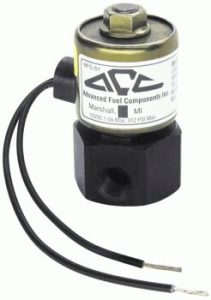Enquiries: 604-421-3108 | info@propanedepot.ca
Standard Marine Propane Setup
General Components

12V Solenoid – Advance Fuel Components Model 121 – #1297
Electric solenoids shut off the gas inside the locker with the flip of a switch that’s conveniently located in the cabin. Safe propane use means shutting off the gas at the tank after every use. You can do that manually by turning the knob on the tank; leaving the gas lines pressurized is not recommended. The solenoid makes it easy to cut the propane supply to the line. The switch should be paired with a bright panel light that warns you that the solenoid valve is open. The solenoid should always be off except when the stove is in use.

Pressure Gauges
A pressure gauge is an essential safety feature, and it must be the first thing connected to the valve on top of the bottle. It can be mounted directly on the bottle or installed on the locker wall and connected to the bottle with a high-pressure pigtail.
The gauge does not tell you the level of the gas in the tank; you weigh the tank to determine that. What the pressure gauge does do is allow you to easily–and frequently–leak test the LPG system.

Twin Stage Regulator
From the solenoid, the gas should flow directly into a step-down regulator that reduces the pressure from 250 psi on the tank side (this varies widely with temperature) to 11″WC in the line that carries the gas to the galley stove or other appliance. This order can be reversed, with the solenoid plumbed after the regulator, but low-pressure solenoids tend to be of lesser quality. A high-pressure solenoid is preferable because it shuts off the gas upstream of the regulator and the rest of the system. In application, either configuration shuts off the gas inside the locker. If you install your solenoid on the high-pressure side, be sure it is rated for high pressure.

Supply Hoses
The fuel line from the regulator (or solenoid valve) to the stove must be continuous–no connections inside the boat except at the stove. Solid copper fuel lines are commonly used, but flexible, high-pressure hose is probably safer for boat use, and it is easier to install.
A threaded adapter can be required to connect the hose to the regulator or solenoid. Use thread sealant on the regulator end of the adapter but not on the end that the hose attaches to. Pipe fittings require gas tape or sealant, but flare and compression fittings do not.
The hose should exit the propane locker near the top, and it should pass through a vapor-tight fitting to prevent gas from leaking out of the locker into the interior of the boat. Use a similar fitting to protect the hose from abrasion everywhere it passes through a bulkhead.
Common straight-through fittings are too short to pass through a plywood bulkhead. You can thin the bulkhead by counter boring one side with a spade bit. Alternatively, cut an oversize hole through the bulkhead with a hole saw, screw a metal or fiberglass cover plate over the hole, and install the fitting through the cover plate. Be sure to protect the hose from abrasion and excessive heat (140°F). LPG hose should run through the top of lockers rather than through their bottoms. Support the hose every 18 inches with nylon cable clamps.
 Gas Detectors
Gas Detectors
Gas detectors add an additional level of safety to an LPG installation. “Sniffers” constantly monitor the air for the presence of LP gas, activating an alarm and shutting off the solenoid when they detect gas at about 10% of minimum explosive level.
Install the gas sensor where gas is likely to accumulate, i.e. as low as possible and near the range.
Recommended Cylinders

Vertical Aluminum cylinders: 6lb (currently not available at our store), 10lb, 20lb, 30lb, and 40lb (currently not available at our store)

Horizontal Aluminum cylinders: 10lb, 20lb, 30lb
– Rust-Free
– Lighter Than Steel
– Must Be Recertified Every 10 Years. We Recertify And Repair Aluminum Cylinders At Our Lake City Way Showroom Location.

Vertical Fiberglass/Composite Cylinders
– 50% Lighter Than Steel
– Translucent: Liquid Propane Level Visible
– 15 Year Lifespan, Must Be Recertified Every 5 Years. We Recertify And Repair Composite/Fiberglass cylinders at our Lake City Way Showroom Location.
– Rust-Free
Dickinson Sea-B-Que Small
- #4531
The Dickinson Sea-B-Que Small is sturdy, neat and compact. This model is the ideal small barbecue for two people. It features hood knobs on the the roll-away hood, to allow for effortless opening and closing even when the barbeque is hot. This design also prevents flame outs in the windiest of conditions.
- 20ga grained 304 marine grade stainless
- Sturdy construction for maximum strength
- Features a 10, 000 BTU burner
- High strength octagonal design
- Roll away hood with hood knobs
- Will not flame out in high winds.
- Attractive design and dock appeal
- One year warranty
- Three year burner warranty
The Sea-B-Que Small comes with deck legs, drip tray, 4 removable porcelain grill sections, a thermometer and a stainless latch to keep the hood closed while storing.
Width: 24″
Height: 12.375″
Depth: 10″
Weight: 18 lbs
Cooking Surface:
W 9.25″ x L 16″
BTU: 10,000 BTU

Propane Depot is closed on public holidays.
VANCOUVER LOCATION
Propane Filling/Cylinder Sales
Ph: 604-872-0800
1940 Main St
Vancouver, BC V5T 3B9
Mon-Fri: 8 am – 6 pm
Sat: 9 am – 6 pm
Sun: 10 am - 6 pm
BURNABY LOCATION
Showroom, Filling, Cylinder Sales
Ph: 604-421-3108
Toll-Free: 1-877-238-1279
3390 Lake City Way
Burnaby, BC V5A 3A6
Mon-Fri: 7 am - 6 pm
Sat: 9 am – 6 pm
Sun: 10 am – 6 pm
OUTSIDE SALES, RENTALS
LARGE PROJECTS
sales@propanedepot.ca
Ph: 236-998-0042
ACCOUNTING
Accounting: 604-564-0364
Receivables
receivables@propanedepot.ca
Payables
payables@propanedepot.ca
